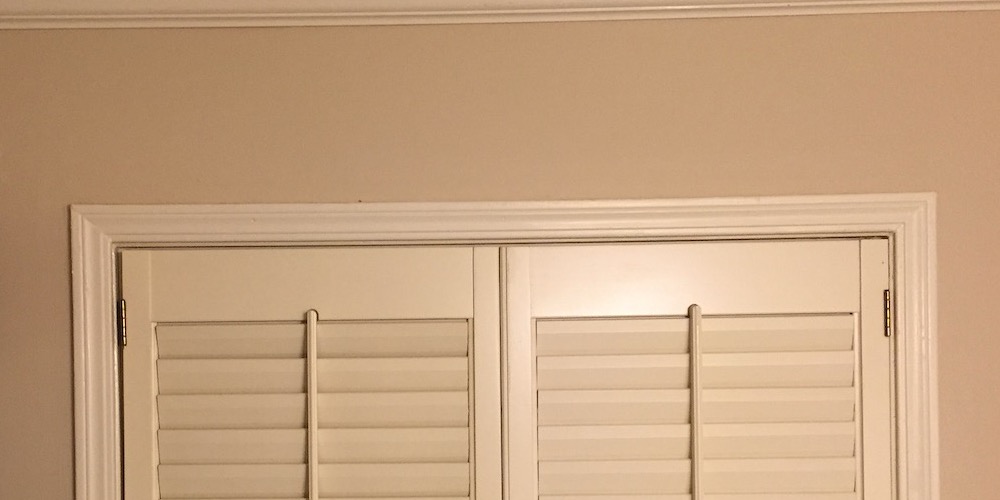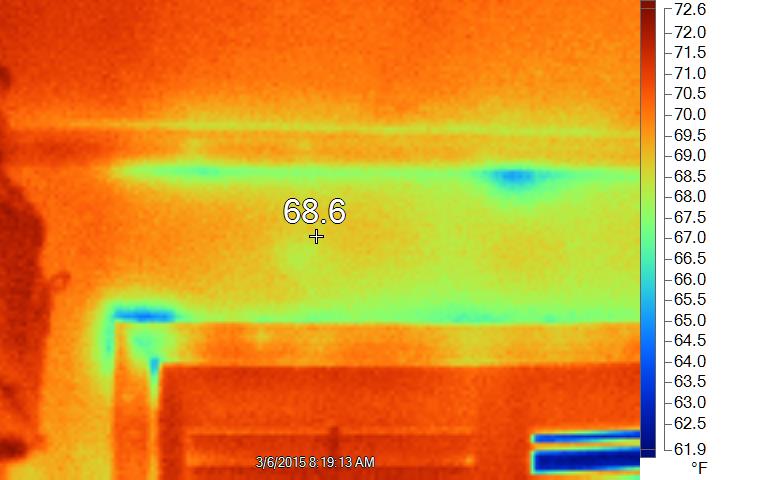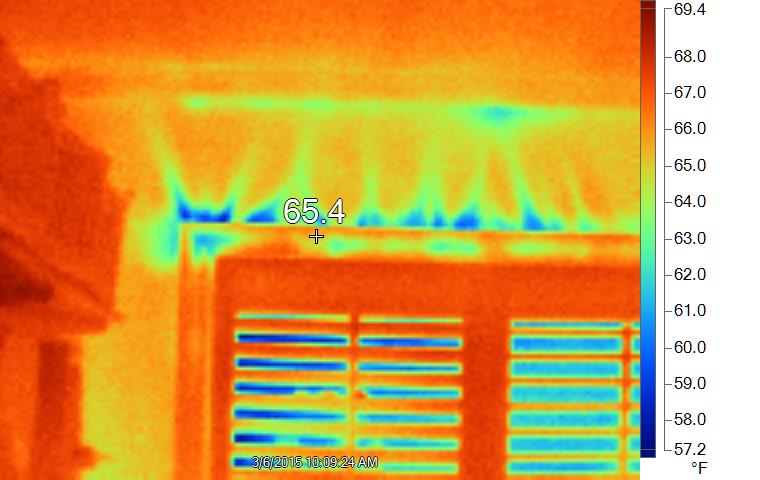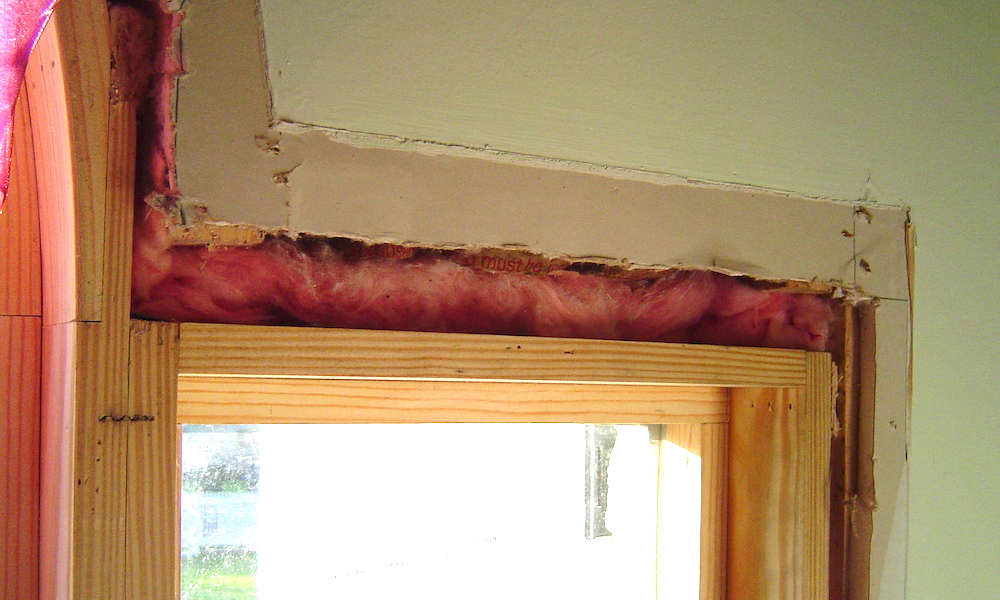Even New Windows Won’t Stop This Heat Loss

This will be a quick article. I just want to show you four images to make a point about heat loss at windows. (I say “at” windows because we all know that windows themselves allow more heat through than the surrounding walls. Here in Atlanta, for example, builders have to insulate walls to R-13 but windows only to ~R-3.) The photo above shows the window as it normally looks, photographed in visible light. Looks fine, right?
The second photo shows the same window photographed in infrared light. The darker the color, the colder that area is. You see a spot of cold near the top left corner of the window and another one at the crown molding. The outdoor temperature at the time was 30° F and it was about 70° F indoors.

The third image shows the same window again, this time photographed in infrared with a blower door running. Yikes! There’s a lot more blue showing now. The blower door put the house under negative pressure and air likes to move from higher to lower pressure when there’s a pathway, so that’s exactly what it did here.

Why is this happening? Because the majority of windows in homes have been installed without proper attention to air sealing around the window frame. If they got anything, it was often a material that doesn’t really stop air leakage.
Take the window shown below, for example. The homeowners were remodeling the home and getting new windows. The installers stuffed fiberglass in that gap. Infrared images of that window probably would look pretty much like the ones above.

If you’re cold in winter when you get close to a window in your home, it may not be the fault of the window itself. If you replace your old single-pane windows with new double-pane low-e windows but don’t take care of that gap, you haven’t solved the whole problem.
Allison A. Bailes III, PhD is a speaker, writer, building science consultant, and the founder of Energy Vanguard in Decatur, Georgia. He has a doctorate in physics and writes the Energy Vanguard Blog. He is also writing a book on building science. You can follow him on Twitter at @EnergyVanguard.
Related Articles
A Good Window Is Still a Poor Wall
Winterizing Your Home? Don’t Caulk the Windows!
Don’t Miss This Opportunity if You’re Replacing Windows
NOTE: Comments are closed.
This Post Has 30 Comments
Comments are closed.

One of my newest "won’t
One of my newest "won’t give up" tools is a spray foam gun that uses replacement FOMO cans. It is always on the jobsite to fill in areas like you show around windows and doors, or any other space I find in the exterior building envelope. I am amazed at how often it is used because it is always available and the canister of foam is good for a couple of months. Previously, I used those Great-stuff cans but those go bad if not used immediately. These guns provide a seal at the very tip of the nozzle that extends the life of the can even from job to job. I foam everything now.
Sadly, years ago-before I got
Sadly, years ago-before I got serious on energy efficiency–we had several vinyl replacement inserts installed and they used fiberglass instead of foam. Is there anything I can do to fix this, short of removing the window?
One of my newest “won’t
One of my newest “won’t give up” tools is a spray foam gun that uses replacement FOMO cans. It is always on the jobsite to fill in areas like you show around windows and doors, or any other space I find in the exterior building envelope. I am amazed at how often it is used because it is always available and the canister of foam is good for a couple of months. Previously, I used those Great-stuff cans but those go bad if not used immediately. These guns provide a seal at the very tip of the nozzle that extends the life of the can even from job to job. I foam everything now.
Yeah, the professional foam
Yeah, the professional foam guns are way better than the cans with straws. You can even buy them at some of the big box stores these days.
I loved the gun I switched to
I loved the gun I switched to instead of the cans, it was a great stuff gun from Lowes as Allison said. THe difference in convenience, accuracy of the bead, and ease of applying was huge. After going through two of them in a few years due them starting to not seal properly I did some research and found the Hilti gun had way better reviews from those that used them every day. THe seal is so tight and so permanent that they don’t recommend using cleaner in between cans and the cans last indefinitely on the gun. IMO they are easily worth the higher cost.
Yes. You don’t have to remove
Yes. You don’t have to remove the whole window. Just take the trim off from the inside, pull the old fiberglass chinking, and use some low-expanding foam made for windows and doors.
Yeah, the professional foam
Yeah, the professional foam guns are way better than the cans with straws. You can even buy them at some of the big box stores these days.
Thanks for the infrared
Thanks for the infrared article.
One of the most prominent
One of the most prominent national window companies actually advertises this kind of "chinking" in their TV ads – and they are charging something like $1000/window to do it.
Sadly, years ago-before I got
Sadly, years ago-before I got serious on energy efficiency–we had several vinyl replacement inserts installed and they used fiberglass instead of foam. Is there anything I can do to fix this, short of removing the window?
Yes. You don’t have to remove
Yes. You don’t have to remove the whole window. Just take the trim off from the inside, pull the old fiberglass chinking, and use some low-expanding foam made for windows and doors.
Thanks for the infrared
Thanks for the infrared article.
One of the most prominent
One of the most prominent national window companies actually advertises this kind of “chinking” in their TV ads – and they are charging something like $1000/window to do it.
Air seal option for the mess
Air seal option for the mess-inclined (me): stuff rough opening w/ fiberglass (to allow errant moisture drainage to outside) & apply airstrop-type sheathing tape, 3m or imports, to jamb face & the r.o. flex wrap… visually confirm seal & install trim
I loved the gun I switched to
I loved the gun I switched to instead of the cans, it was a great stuff gun from Lowes as Allison said. THe difference in convenience, accuracy of the bead, and ease of applying was huge. After going through two of them in a few years due them starting to not seal properly I did some research and found the Hilti gun had way better reviews from those that used them every day. THe seal is so tight and so permanent that they don’t recommend using cleaner in between cans and the cans last indefinitely on the gun. IMO they are easily worth the higher cost.
Air seal option for the mess
Air seal option for the mess-inclined (me): stuff rough opening w/ fiberglass (to allow errant moisture drainage to outside) & apply airstrop-type sheathing tape, 3m or imports, to jamb face & the r.o. flex wrap… visually confirm seal & install trim
Just another thought to
Just another thought to consider. I build coastal hurricane resistant homes. By using closed cell foam around the perimeter of all windows and doors, I have greatly increased by DP rating. My windows and doors are effectively glued into the structure.
We are a large window and
We are a large window and door retailer and installer in New England . I agree with both Kevin and Thomas ; all too often Builders and installers just think one sided. This both an interior insulation issue and proper exterior sealing issue. Both from cold migration and air and Moisture sealing. Great article and proof-telling pictures
Good point, Thomas. Closed
Good point, Thomas. Closed cell spray foam improves the structural strength of buildings.
Just another thought to
Just another thought to consider. I build coastal hurricane resistant homes. By using closed cell foam around the perimeter of all windows and doors, I have greatly increased by DP rating. My windows and doors are effectively glued into the structure.
Good point, Thomas. Closed
Good point, Thomas. Closed cell spray foam improves the structural strength of buildings.
Does closed-cell foam come in
Does closed-cell foam come in the low-expansion variety, Thomas?
I have seen low-expansion
I have seen low-expansion foam available. I use the same for everything, but the windows that I use are Viwinco impact rated with very solid frames, so I have had no problems with expansion moving the frames around. We foam everything.
We are a large window and
We are a large window and door retailer and installer in New England . I agree with both Kevin and Thomas ; all too often Builders and installers just think one sided. This both an interior insulation issue and proper exterior sealing issue. Both from cold migration and air and Moisture sealing. Great article and proof-telling pictures
Remember that the 2012 and
Remember that the 2012 and 2015 IECC require that non air permeable air sealing be performed around windows and doors in new homes.
Remember that the 2012 and
Remember that the 2012 and 2015 IECC require that non air permeable air sealing be performed around windows and doors in new homes.
Does closed-cell foam come in
Does closed-cell foam come in the low-expansion variety, Thomas?
I have seen low-expansion
I have seen low-expansion foam available. I use the same for everything, but the windows that I use are Viwinco impact rated with very solid frames, so I have had no problems with expansion moving the frames around. We foam everything.
I had Milgard replacement
I had Milgard replacement windows installed many years ago. Back then the "conventional wisdom was that expanding foam would warp the windows and even Milgard discouraged foam. My installed used some low expanding foam shot from guns and had no warping issues. I later installed more windows myself and bought the same low expansion foam. Given that my SoCal 2100 sq ft SoCal 2 story house has 400 sq ft of windows, I’m so glad my installer, Newman Windows, did not list to conventional wisdom. I have so many other issue with this 1987 tract home that I’m glad this upgrade was done correctly. Now if I can only convince my HVAC contractor that a 4 ton AC, even with 5 stages, is too large for my home. Seems like even a Manual J doesn’t sway them. But that’s for another blog, lol. Thanks for the great site!
I had Milgard replacement
I had Milgard replacement windows installed many years ago. Back then the “conventional wisdom was that expanding foam would warp the windows and even Milgard discouraged foam. My installed used some low expanding foam shot from guns and had no warping issues. I later installed more windows myself and bought the same low expansion foam. Given that my SoCal 2100 sq ft SoCal 2 story house has 400 sq ft of windows, I’m so glad my installer, Newman Windows, did not list to conventional wisdom. I have so many other issue with this 1987 tract home that I’m glad this upgrade was done correctly. Now if I can only convince my HVAC contractor that a 4 ton AC, even with 5 stages, is too large for my home. Seems like even a Manual J doesn’t sway them. But that’s for another blog, lol. Thanks for the great site!